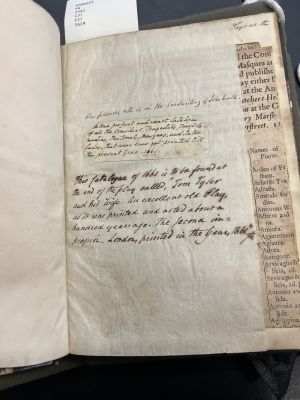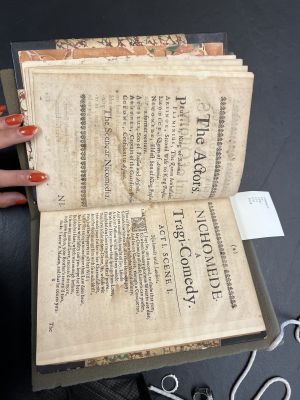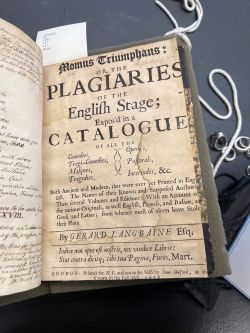Edwin Forrest's Plays: Difference between revisions
No edit summary |
No edit summary |
||
| Line 45: | Line 45: | ||
The book points to a variety of authors and sources, as apparent by the different styles of pasting and different handwritings. However, the uniformity in the color, style, and letters of the frequently recurring author, who replicates the writings of others, appears to be the primary consolidator and scrapbooker of this material. This may suggest that this scrapbook began as another’s possession, before being transferred to somebody else who further broadened and developed it. | The book points to a variety of authors and sources, as apparent by the different styles of pasting and different handwritings. However, the uniformity in the color, style, and letters of the frequently recurring author, who replicates the writings of others, appears to be the primary consolidator and scrapbooker of this material. This may suggest that this scrapbook began as another’s possession, before being transferred to somebody else who further broadened and developed it. | ||
One example of this is above a list of plays and their authors. The paragraph describing this page is the same as written twice on the first page of the book (once by John Kemble, once by the recurring author): ““A true, perfect, and exact catalogue of all the comedies, tragedies, tragi-comedies, pastorals, masques and interludes, that were ever yet printed and published, till this present year 1661…” Above it, from what I could make out, it is written in the recurring author’s handwriting “[ilegible]’s Old Law has a Catalogue of Plays as the prompter p. 79.” I believe that the combination of these instances points to the fact that a secondary author consolidated and annotated materials that others collected into a singular book, which was professionally bound. While the book is professionally bound, the pages largely lack uniformity and organization, possessing no apparent structure and possessing a wide variety of sources and pasting styles and further pointing to this leather scrapbook not being some of the materials' original place. | One example of this is above a list of plays and their authors. The paragraph describing this page is the same as written twice on the first page of the book (once by John Kemble, once by the recurring author): ““A true, perfect, and exact catalogue of all the comedies, tragedies, tragi-comedies, pastorals, masques and interludes, that were ever yet printed and published, till this present year 1661…” Above it, from what I could make out, it is written in the recurring author’s handwriting “[ilegible]’s Old Law has a Catalogue of Plays as the prompter p. 79.” I believe that the combination of these instances points to the fact that a secondary author consolidated and annotated materials that others collected into a singular book, which was professionally bound. While the book is professionally bound, the pages largely lack uniformity and organization, possessing no apparent structure and possessing a wide variety of sources and pasting styles and further pointing to this leather scrapbook not being some of the materials' original place. | ||
While I speculate this to be Forrest, this is not concretely confirmed anywhere. This in part comes from its professionally binding and titling, with gold letters reading ''Plays'' and ‘F’ along the spine | [[File:Nichomede.jpg|300px|thumb|left|A sample of Forrest's handwriting.]] | ||
While I speculate this to be Forrest, this is not concretely confirmed anywhere. This in part comes from its professionally binding and titling, with gold letters reading ''Plays'' and ‘F’ along the spine. | |||
Revision as of 17:28, 4 May 2022
Plays is a scrapbook containing ephemera related to English plays of the 17th and 18th centuries. This scrapbook was possessed by Edwin Forrest, a prominent American actor, collector, and head of the Edwin Forrest House in Philadelphia. Cataloged as, [Cast lists and booksellers' catalogs and advertisements of English plays extracted from numerous 17th and early 18th century sources], it resides in the Kislak Center for Special Collections, Rare Books and Manuscripts at the University of Pennsylvania, purchased during the acquisition of the Edwin Forrest Library and Collection. This scrapbook is intended for personal use, rather than mass-circulation to document and catalog various English plays and their details.

Genre
Plays consolidates a wide variety of material, including cutouts from Playbills, advertisements, cast lists, and other texts. This form of scrapbooking was a private effort [likely] to catalog and detail a deep interest in English plays. Personal scrapbooks are used to explore material that matters to an individual. Plays was not made for wide circulation, as shown by its lack of solid structure and organization; it aims to consolidate its material to express an interest in its particular subject. Rather than to use another book as a source to do so, scrapbooks allow the opportunity to specifically select and sift through writings and personally select what is present in the collection. During the 18th century, as scrapbooking in America became more prevalent and widespread, it became an activity often taken up by actors. Many saved their own reviews and playbills to document their occurrences, in a time where the internet and articles would not be present to do so on their behalf. This may speak to an effort of Plays to consolidate material that would not be so easily available in the future.
Historical Context
Edwin Forrest
Edwin Forrest (March 9, 1806 – December 12, 1872) was an American actor during the nineteenth century. He acted in a number of famous Shakespeare plays, and was the subject of a number of social scandals. Forrest’s success in part came from his rugged, powerful, and patriotic presentation and style of acting. He furthered this image by encouraging American authorships of plays, by offering prizes for their writings. A philanthropist and patron of the arts, his legacy lives on today, and he is remembered as one of the greatest actors in American history. He was an avid lover of English dramas and amassed a wide collection of theatrical literature.
Edwin Forrest Library and Collection
Forrest purchased a mansion in 1855 in Philadelphia, where he retired after the stage. He collected America’s largest dramatic library in this estate. Contains other scrapbooks, suggesting his making of this one
English Plays and Effects on American Culture
Material Analysis
External Structure and Appearance

The official title written on the book reads “Plays”. This is inscribed in gold lettering on the spine of the book, alongside a golden ‘F’ near the bottom of the spine. The inside cover states that the book belongs to “The Edwin Forrest Home, Philadelphia, PA,” the F likely referring to Forrest. The book possesses a water-marble design on the front, back, and inside of the covers. This paper marbling was a common practice for security and aesthetic reasons. Despite being a scrapbook, the book is professionally bound and titled. The first page has a handwritten note which has been copy and pasted into the book, reading, “A true, perfect, and exact catalogue of all the comedies, tragedies, tragi-comedies, pastorals, masques and interludes, that were ever yet printed and published, till this present year 1661…” Above this, it is written “The following note is in the handwriting of John Kemble.” This writing may be Forrest’s handwriting, suggested by comparing it to other writings of his. This may point to the idea that this book perhaps belonged to Kemble, and transitioned to Forrest. It is unclear exactly who Kemble is, but this introduction to the book suggests that he may have been one of the original authors. I later found this exact description from an officially printed catalog cut and pasted into the book; I speculate that this may mean that the book’s purpose is the same as the catalog, but perhaps the author possessed a desire to improve upon it. The book seems to be constructed by two different folios, as the spine possesses a split with two seams on either side.
Internal Contents
Scrapbooked Documents

Cast Lists
Various castlists are cut from playbills and texts to document actors participating in a number of plays. These include Deferring favorite [1629], The Dutchesse of Malfy / John Webster (1640), and Evening's love [1671]. Playbills and Advertisments
Acts and Scenes
There are a number of excerpts from various English plays throughout the scrapbook, including but not limited to: Oedipus [1692] Love triumphant [1693] Nero [1696] Much of the works in this book come from Shakespeare, which is to be expected of a book analyzing English dramas. The book contains lines, scenes, and even entire acts from a number of plays. The variability in the length of each incorporated play may speak to the lack of easy access of entire plays for personal use during this time period, as whole plays were likely not being frequently printed and circulated while the printing press was in use. One notable instance is of the play Nichomede, a Tragi-comedy. This play includes a list of actors and entire scenes. This does not appear to be a play whose popularity has continued until today, as little information is found on it. This fact speaks to the efforts of the book in question to maintain and document the history of plays.

Annotations and Writings
There are instances of notes and annotations in different handwritings, pointing to a variety of authors participating in the creation of the book. For example, there are multiple occurrences of an initial annotation, followed by the same words repeated. While the handwritings of the initial annotations tend to vary, the secondary repeated annotations seem to be rather uniform. The style of the writing of the initial paragraph in the cover, which introduces and replicates John Kemble’s initial paragraph, also appears to be written by the same author. This recurring author not only replicates the handwritings of others but copies down advertisements, descriptions of plays, and playbills alongside the text in question. In some cases, simply the name of the play is written down, while in others, entire pages are taken up by the copying of playbills. One notable instance of this is when an entire advertisement is copied, filling an entire page with writing. I believe this speaks to the fact that this book was a personal endeavor to document this history. Despite the widespread distribution of ephemera and advertisements, they do not remain indefinitely, and are to be discarded unless somebody makes an effort to retain them.

Incorporation of Materials
There is not much uniformity in the style of pasting much of the texts into this book. While some pages are pasted on top of others, browning, and chipping at the edges, others are almost professionally incorporated, with seamless edges attaching them to the pages. Some pages are even cleaved near the spine, before barely attaching a much smaller castlist or advertisement to their edge.
Speculation
The book points to a variety of authors and sources, as apparent by the different styles of pasting and different handwritings. However, the uniformity in the color, style, and letters of the frequently recurring author, who replicates the writings of others, appears to be the primary consolidator and scrapbooker of this material. This may suggest that this scrapbook began as another’s possession, before being transferred to somebody else who further broadened and developed it. One example of this is above a list of plays and their authors. The paragraph describing this page is the same as written twice on the first page of the book (once by John Kemble, once by the recurring author): ““A true, perfect, and exact catalogue of all the comedies, tragedies, tragi-comedies, pastorals, masques and interludes, that were ever yet printed and published, till this present year 1661…” Above it, from what I could make out, it is written in the recurring author’s handwriting “[ilegible]’s Old Law has a Catalogue of Plays as the prompter p. 79.” I believe that the combination of these instances points to the fact that a secondary author consolidated and annotated materials that others collected into a singular book, which was professionally bound. While the book is professionally bound, the pages largely lack uniformity and organization, possessing no apparent structure and possessing a wide variety of sources and pasting styles and further pointing to this leather scrapbook not being some of the materials' original place.

While I speculate this to be Forrest, this is not concretely confirmed anywhere. This in part comes from its professionally binding and titling, with gold letters reading Plays and ‘F’ along the spine.